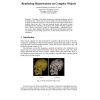Free Online Productivity Tools
i2Speak
i2Symbol
i2OCR
iTex2Img
iWeb2Print
iWeb2Shot
i2Type
iPdf2Split
iPdf2Merge
i2Bopomofo
i2Arabic
i2Style
i2Image
i2PDF
iLatex2Rtf
Sci2ools
SIGGRAPH
1989
ACM
1989
ACM
Hypertexture
This paper will examine hypertexture rendering techniques and will demonstrate how volume data sets may be adapted in order for hypertexture to be applied. Details are given of a conversion process for implicit functions and complex objects, such as CT data and triangular meshes, into suitable volume data. Hypertexture is applied to these objects and example renderings include the UNC CThead, a chess piece, a tank and a dodecahedron. Additional information is given about defining soft objects, defining density modulation functions, ray marching and controlling hypertexture, so that results presented here can be reproduced.
Computer Graphics | Hypertexture Rendering Techniques | SIGGRAPH 1989 | Suitable Volume Data | Volume Data |
| Added | 11 Aug 2010 |
| Updated | 11 Aug 2010 |
| Type | Conference |
| Year | 1989 |
| Where | SIGGRAPH |
| Authors | Ken Perlin, Eric M. Hoffert |
Comments (0)

